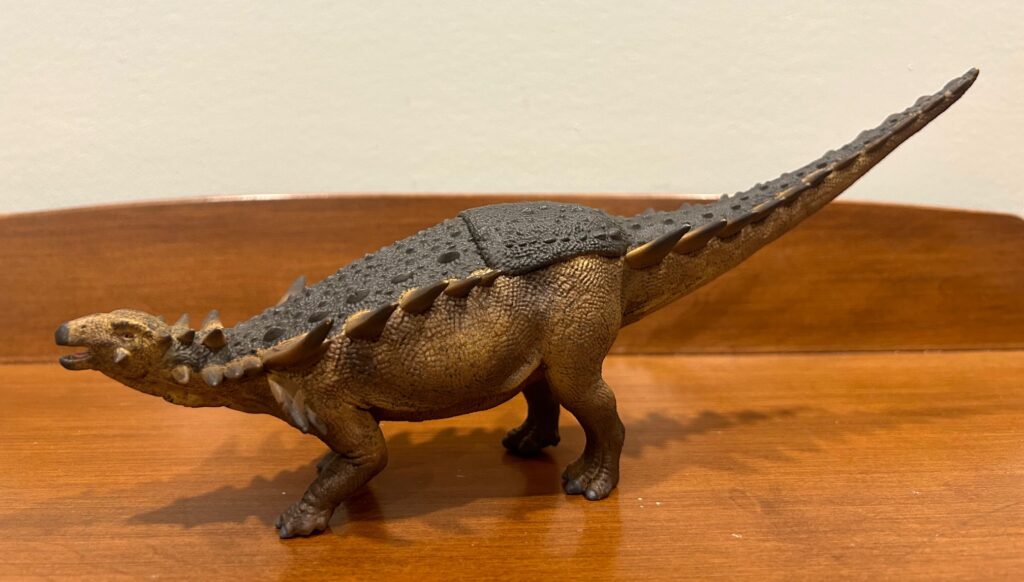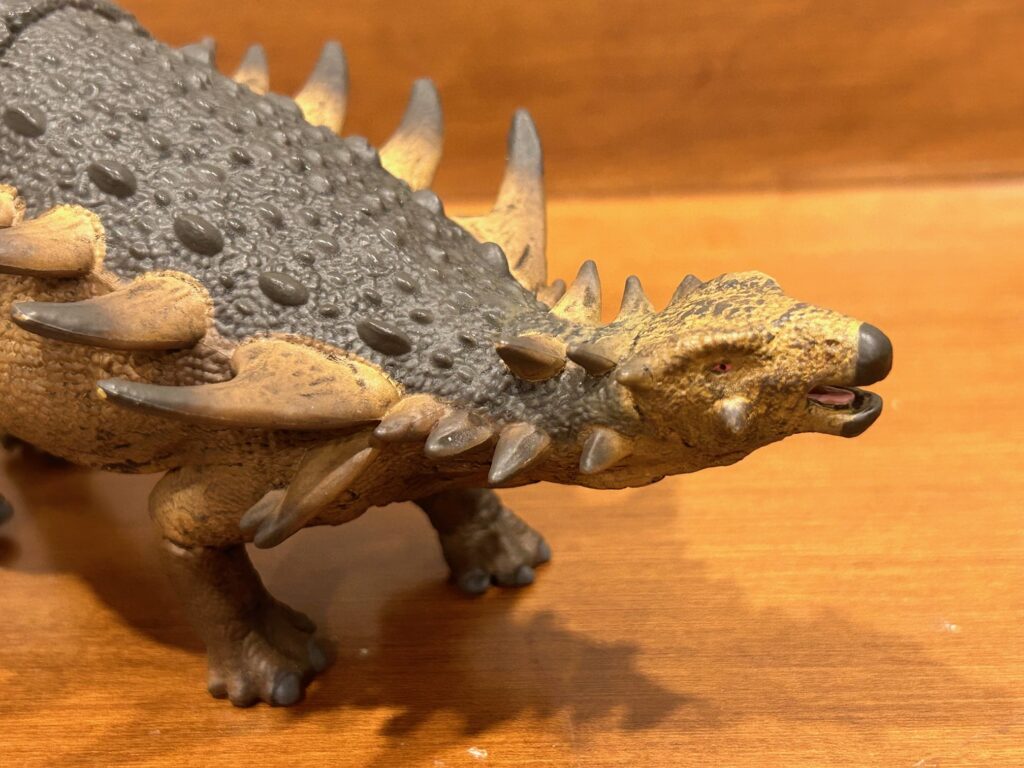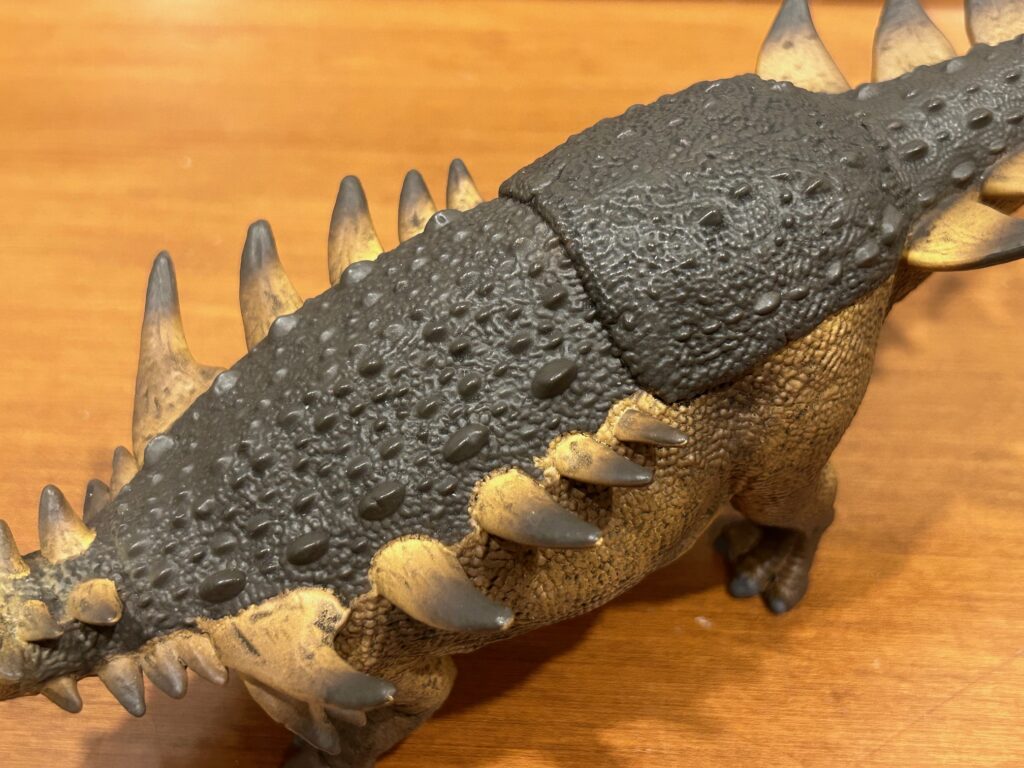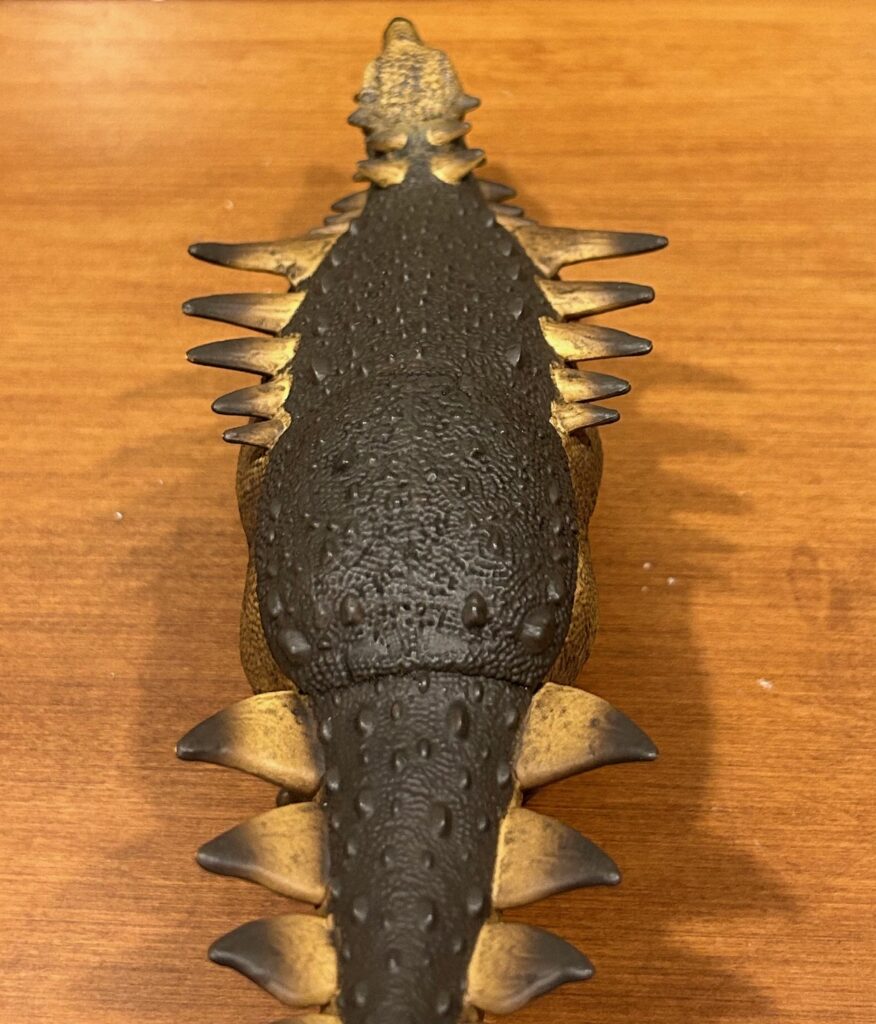
The very first time I laid eyes on the Early Cretaceous ankylosaurian known as Polacanthus was at a birthday party when I was only four or five years old. I can’t rightly recall if it was my own or some other child’s, but I’ll never forget that wrapping paper. Someone had brought a gift done up in dinosaur-themed paper. And not cartoonish dinosaurs wearing party hats and clutching balloons, but rather actual paleoart done in the style of the early 1980s. There was Allosaurus and Stegosaurus and Brontosaurus and Tyrannosaurus rex confronting Triceratops in a manner suspiciously resembling the work of one Charles R. Knight. And there was also a dinosaur I had never heard of before: the aforementioned Polacanthus. It had a head that looked like Stegosaurus‘, but then it had two rows of curved spikes running down its back, a bumpy shield over its hips, and then more rows of spikes running down its tail. Needless to say, I thought it was one of the coolest-looking dinosaurs I’d seen yet and I soon took to drawing pictures of it. I haven’t been able to find any images of the wrapping paper online, but I was able to find this fine piece of vintage artwork by one Neave Parker, which I am convinced was the basis for the Polacanthus on that paper more than 40 years ago now.

CollectA released their first Polacanthus all the way back in 2008, and I daresay it was not well received. But we all know that they’ve come a very long way since then, and they’ve been slowly but steadily replacing their most glaringly outdated toys with new and improved versions. They’ve also been on quite the jolly old English kick for the past six or so years, what with Baryonyx, Brighstoneus, Ceratosuchops, Iguanodon, Mantellisaurus, Megalosaurus, and Neovenator. So really, it came as little surprise when the 2024 Deluxe Polacanthus was announced last fall.

This heavily armoured herbivore is sculpted with its front limbs bent, its mouth open, its head raised, and its tail raised even higher. Looks like it’s putting on a show of strength and defiance, either towards a rival of its own kind or an approaching carnivore. From nose to tail tip, it measures just over 28 cm long and is just over 12 cm high at that tail tip. This makes the Polacanthus CollectA’s longest thyreophoran to date, although the Stegouros remains the biggest.



The Polacanthus‘ main colours are dark chocolate and sugary brown, with dark wash applied to the latter. Dark brown is also applied on the feet and the tips of the many spikes. The claws and beak are very dark grey, the tongue is dull pink, and the tiny eyes are glossy orange. All in all, this animal is anything but vivid and striking. Some light-coloured stripes running vertically or horizontally along the body would have gone a long way. But at the same time, there can be no denying that this colour scheme is perfectly believable. The Wessex Formation on the Isle of Wight where Polacanthus was first discovered in 1865 by the Reverend William Fox would have been semi-arid and similar to Mediterranean shrubland, so a herbivore done up in shades of brown like this probably would have blended in nicely.

As with most ankylosaurs, the limbs on this Polacanthus are relatively short and sturdy-looking. The front feet end in five digits, with the outermost two being reduced and without claws. The hind feet end in four digits, all with claws, and with the innermost one reduced. The limbs, underbelly, and flanks are covered in small rounded scales. Thick folds of skin further add to the animal’s beefy appearance. The head is roughly triangular-shaped when viewed from the top. A small conical scute juts out from beneath each eye. Two similar-sized scutes are to be found at the back of the skull. The flattened cranium is relatively smooth and covered in large scales.

The neck is well protected by multiple spikes on the top and sides and there are two downward facing spikes on each humerus. Jutting out from the Polacanthus‘ shoulders are the very largest spikes, curved, flattened, blade-like, and angled slightly upward. These are followed by four pairs of progressively smaller spikes. The back features two rows of small keeled osteoderms flanking the spikes and a whole multitude of smaller osteoderms between them.


Next up is the pelvic or sacral shield, perhaps the most defining physical feature of Polacanthus. It is a large bony shield covered in scales and osteoderms of all sizes that would have protected the hip region from attack. Similar pelvic shields can be found on Gastonia and Mymoorapelta, which would strongly indicate that Polacanthus belongs to the nodosaurid family as well. Finally, we come to the tail. It too is covered in keeled osteoderms, and jutting out from either side is a row of wide, flattened plates. They start out as large ones near the base of the tail and gradually become smaller and blunter towards the tip. In a subtle realistic touch, one plate on the right side has had the tip broken off. Polacanthus presumably used its tail in intraspecific combat as well as for defense against the likes of Neovenator, so this injury could be a result of either.


So now that we’ve gone over this toy from one end to the other, you may be wondering just how accurate it is. Well, I’m afraid that it is impossible to say, at least at this time. Despite being one of the more famous English dinosaurs, Polacanthus has always been known only from very scant fossil remains. The holotype specimen includes the pelvic shield, the sacrum, most of the pelvis, most of the left hind leg, the right femur, and assorted ribs, vertebrae, and spikes, but no skull, no neck, no front limbs, and no proper indication of how all the spikes were arranged on the animal. A 2020 review of English ankylosaurians came to the unfortunate conclusion that several subsequently discovered specimens, including one with skull and neck material and anterior armour, could not be confidently referred to Polacanthus, thereby leaving only the holotype. Various restoration attempts have been made over the centuries, including one by the legendary Franz Nopsca, who was the first to propose that there were two rows of spikes on both the body and the tail, but the simple fact remains that we can’t be certain how this dinosaur really looked.

In doing my research for this review, I shared images of the toy with paleontologist William T. Blows, whose distinguished career includes quite a bit of work on Polacanthus. His response was that while the head and the arrangement of spikes around the neck region are indeed speculative, the pelvic shield and the four rows of spikes are as accurate as anyone can say at this time. There is no evidence of any additional rows as featured on the old CollectA toy or the one from Papo. He also noted that:
” . . . given the limitations of the knowledge, and the size of the model, I don’t think we can get any better than this just now. Maybe, if and when new specimens are found, this model may become out of date. But currently I think this is good. I would have be delighted to show this model to William Fox who spent many hours collecting and preserving what was to be the holotype for us to study.”

Time may well someday render this toy to inaccurate, but right now, I would consider this to be the very best plastic representation of Polacanthus on the market, what with its grand appearance and excellent sculpting. Indeed, it really doesn’t look all that different from the wondrous creature on that wrapping paper that impressed me so all those years ago. Definitely an enjoyable and worthwhile acquisition. Assuming CollectA intends to continue with more English dinosaurs, I think that Scelidosaurus would be a prime candidate, as the present toy is definitely showing its age. The same goes for Cetiosaurus. We’ll just have to wait and see what 2025 brings. And many happy thanks for the review sample, CollectA!

Support the Dinosaur Toy Blog by making dino-purchases through these links to Ebay and Amazon. Disclaimer: links to Ebay.com and Amazon.com on the The Dinosaur Toy Blog are often affiliate links, when you make purchases through these links we may make a commission
Trending Products











